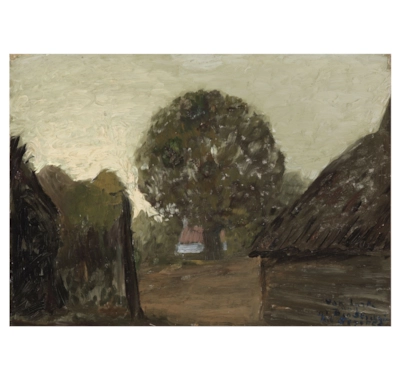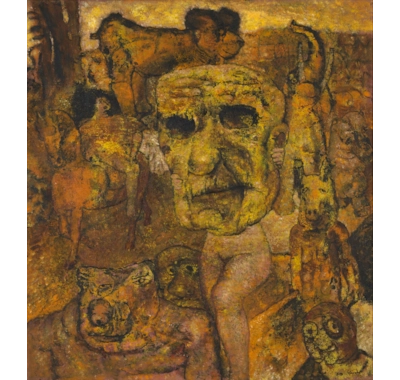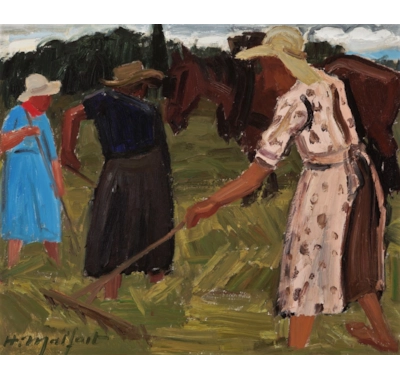Hubert Malfait
(1898 - 1971)
Woman with coffee mill
1926
Oil on canvas
117 x 73 cm
Signed top left : HMalfait
Oil on canvas
117 x 73 cm
Signed top left : HMalfait
- André De Ridder, Antwerp
- E.L.T. Mesens, Brussels
- Dr. F. Van den Broucke, Ghent
- Van den Broecke, Brussels
- E.L.T. Mesens, Brussels
- Dr. F. Van den Broucke, Ghent
- Van den Broecke, Brussels
1926 was an eventful year for Hubert Malfait. He participated in the group exhibition at the Stedelijk Museum in Amsterdam and the Venice International Biennale. In the summer of 1926, he exhibited in the group exhibition at the Galerie à la Vièrge in Brussels and in the autumn he was represented at Galerie L'Oeuvre in Antwerp. From October 1926, Malfait started working under a contract at Galerie Sélection. He was supported by André De Ridder and Georges Marlier.
During this period, Malfait painted with creamy layers of paint and with coarse and broad brushstrokes. His human figures are monumental. They completely fill the foreground of his works, as in this painting 'Woman with coffee grinder'.
The painting 'Woman with coffee grinder' depicts the everyday reality of his immediate village surroundings. Characteristic of his expressionist period (1923-1931) this period is the importance the artist attaches to the human figure: Woman with coffee grinder. This figure composition was devised and leans towards the classical figures of his artist friend Gust. De Smet. The woman figure stands out for its sense of construction, firmness, concentration and simplicity. The large, closed surfaces Malfait undoubtedly saw in the work of André Lhote. Malfait creates an alienating and intricate structure in unusual areas of colour. The sculptural character of the figure in Woman with coffee grinder has disappeared. Fine colour tonalities and thinner paint typify the quality of this expressionist work. The forms are closed, the outlines of the surfaces are finer, less accentuated. The fluidity of the line and the drawn-out figure are a silent hint to Modigliani's portraits.
During this period, Malfait painted with creamy layers of paint and with coarse and broad brushstrokes. His human figures are monumental. They completely fill the foreground of his works, as in this painting 'Woman with coffee grinder'.
The painting 'Woman with coffee grinder' depicts the everyday reality of his immediate village surroundings. Characteristic of his expressionist period (1923-1931) this period is the importance the artist attaches to the human figure: Woman with coffee grinder. This figure composition was devised and leans towards the classical figures of his artist friend Gust. De Smet. The woman figure stands out for its sense of construction, firmness, concentration and simplicity. The large, closed surfaces Malfait undoubtedly saw in the work of André Lhote. Malfait creates an alienating and intricate structure in unusual areas of colour. The sculptural character of the figure in Woman with coffee grinder has disappeared. Fine colour tonalities and thinner paint typify the quality of this expressionist work. The forms are closed, the outlines of the surfaces are finer, less accentuated. The fluidity of the line and the drawn-out figure are a silent hint to Modigliani's portraits.
- 1927, Brussel, Galerie Le Centaure, Hubert Malfait - A. De Kat, no. 5.
- 1931, Brussel, Paleis voor Schone Kunsten, L'Art Vivant en Europe, no. 193A.
- 1952, Brussel, Paleis voor Schone Kunsten, L'Expressionnisme belge, no. 61.
- 1962, Gent, Galerij Vyncke-Van Eyck, Huldetentoonstelling gewijd aan de Gentse expressionisten en hun leraar J. Delvin.
- 1968, Oostende, Museum voor Schone Kunsten, Hubert Malfait, no. 7.
- 1970, Gent, Bank van Brussel, Hubert Malfait in privéverzamelingen, no. 1.
- 1973, Deinze, MuDeL, Retrospectieve Hubert Malfait, no. 5.
- 1977, Marke, Ontmoetingscentrum, Aspekten van het Vlaams Expressionisme, no. 54.
- 1988, Vinkem-Beauvoorde, Kerk Vinkem-Beauvoorde, Vrouwen in de kunst, no. 50.
- 1988, Deurle, Leon De Smet Museum, Tentoonstelling Hubert Malfait in 30 werken (periode 1923-1931), no. 8.
- 1991-92, Gent, VDK Spaarbank/Galerij Van Langenhove, Groeten uit 1926, no. 48.
- 1931, Brussel, Paleis voor Schone Kunsten, L'Art Vivant en Europe, no. 193A.
- 1952, Brussel, Paleis voor Schone Kunsten, L'Expressionnisme belge, no. 61.
- 1962, Gent, Galerij Vyncke-Van Eyck, Huldetentoonstelling gewijd aan de Gentse expressionisten en hun leraar J. Delvin.
- 1968, Oostende, Museum voor Schone Kunsten, Hubert Malfait, no. 7.
- 1970, Gent, Bank van Brussel, Hubert Malfait in privéverzamelingen, no. 1.
- 1973, Deinze, MuDeL, Retrospectieve Hubert Malfait, no. 5.
- 1977, Marke, Ontmoetingscentrum, Aspekten van het Vlaams Expressionisme, no. 54.
- 1988, Vinkem-Beauvoorde, Kerk Vinkem-Beauvoorde, Vrouwen in de kunst, no. 50.
- 1988, Deurle, Leon De Smet Museum, Tentoonstelling Hubert Malfait in 30 werken (periode 1923-1931), no. 8.
- 1991-92, Gent, VDK Spaarbank/Galerij Van Langenhove, Groeten uit 1926, no. 48.
- Roelandts, O., "Kunstkroniek. Zaal Centaure - Brussel. Tentoonstelling H. Malfait en A. De Kat," in: Vooruit (25.05.1927).
- De Ridder, A., "Hubert Malfait," in: Sélection (Antwerpen: mei-juni 1927), p. 626 (ill.).
- Van Hoogenbemt, A., "De nieuwe generatie - Hubert Malfait," in: Kunst, nr. 2-3, jg. 5 (Gent, 1934), p. 61.
- Langui, E., "Hubert Malfait of de geslachtofferde generatie," in: Vooruit (16.01.1938).
- Langui, E., L'expressionnisme belge, exh. cat. (Bruxelles: Palais des Beaux-Arts, 1952), 28, no. 61.
- Haesaerts, P., Sint-Martens-Latem. Gezegend oord van de Vlaamse kunst (Brussel: Arcade, 1965), 367.
- Edebau, F. Hubert Malfait, exh. cat. (Oostende: Museum van Schone Kunsten, 1968), no. 7.
- Langui, E., Het expressionisme in België (Brussel: Laconti, 1970), p. 167.
- Waterschoot, H., "Hubert Malfait," in: Kultureel Jaarboek van de Provincie Oost-Vlaanderen 1971 (Gent: 1972), p. 378 (ill.).
- Huys, P., Retrospectieve Hubert Malfait, exh. cat. (Deinze: MuDeL, 1973), no. 5.
- D'Haese, J., , Aspekten van het Vlaams Expressionisme, exh. cat. (Marke: Kunstkring Joost De Clercq, 1977), p. 27, no. 54.
- Peeters, D., Hubert Malfait (Antwerpen: Artiestenfonds, 1978), p. 10.
- Duchateau, M., Hubert Malfait (Tielt: Lannoo, 1979), p. 36, 115 (ill.).
- Vanrobaeys, P. & S. Malfait, Hubert Malfait oeuvre-catalogus (Tielt: Lannoo, 1986), p. 47, 102, no. 46 (ill.).
- D'Haese, J., Tentoonstelling Hubert Malfait in 30 werken (periode 1923-1931), exh. cat. (Deurle: Museum Leon De Smet, 1988), p. 17, no. 8 (ill.).
- Poulain, N. e.a., Groeten uit 1926 (Gent: VDK Spaarbank, 1991), p. 79, no. 48 (ill.).
- De Ridder, A., "Hubert Malfait," in: Sélection (Antwerpen: mei-juni 1927), p. 626 (ill.).
- Van Hoogenbemt, A., "De nieuwe generatie - Hubert Malfait," in: Kunst, nr. 2-3, jg. 5 (Gent, 1934), p. 61.
- Langui, E., "Hubert Malfait of de geslachtofferde generatie," in: Vooruit (16.01.1938).
- Langui, E., L'expressionnisme belge, exh. cat. (Bruxelles: Palais des Beaux-Arts, 1952), 28, no. 61.
- Haesaerts, P., Sint-Martens-Latem. Gezegend oord van de Vlaamse kunst (Brussel: Arcade, 1965), 367.
- Edebau, F. Hubert Malfait, exh. cat. (Oostende: Museum van Schone Kunsten, 1968), no. 7.
- Langui, E., Het expressionisme in België (Brussel: Laconti, 1970), p. 167.
- Waterschoot, H., "Hubert Malfait," in: Kultureel Jaarboek van de Provincie Oost-Vlaanderen 1971 (Gent: 1972), p. 378 (ill.).
- Huys, P., Retrospectieve Hubert Malfait, exh. cat. (Deinze: MuDeL, 1973), no. 5.
- D'Haese, J., , Aspekten van het Vlaams Expressionisme, exh. cat. (Marke: Kunstkring Joost De Clercq, 1977), p. 27, no. 54.
- Peeters, D., Hubert Malfait (Antwerpen: Artiestenfonds, 1978), p. 10.
- Duchateau, M., Hubert Malfait (Tielt: Lannoo, 1979), p. 36, 115 (ill.).
- Vanrobaeys, P. & S. Malfait, Hubert Malfait oeuvre-catalogus (Tielt: Lannoo, 1986), p. 47, 102, no. 46 (ill.).
- D'Haese, J., Tentoonstelling Hubert Malfait in 30 werken (periode 1923-1931), exh. cat. (Deurle: Museum Leon De Smet, 1988), p. 17, no. 8 (ill.).
- Poulain, N. e.a., Groeten uit 1926 (Gent: VDK Spaarbank, 1991), p. 79, no. 48 (ill.).
You May Also Like
Hubert Malfait
(1898 - 1971)
Woman with coffee mill








